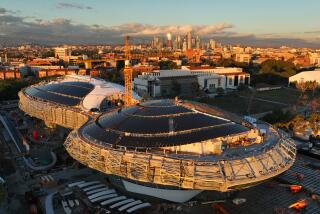Bruised profession strives to tell its story
- Share via
WASHINGTON — As the news media’s reputation with the public glows ever dimmer, a leading journalism foundation is trying to restore a bit of luster by opening a museum dedicated to the news industry and a companion memorial to journalists killed while on assignment.
The purpose is to “give visitors a deeper understanding of the function and role of the free press,” especially at a time when polls show journalism is held in low regard by many Americans, said Allen H. Neuharth, chairman of the Freedom Forum journalism foundation and former chairman of Gannett Co., the nation’s largest newspaper group.
“Anything that helps the public learn about what the media really do--what the job is really like--is a plus in the current atmosphere,” said Neuharth, who conceived of the museum and memorial. The Freedom Forum is a nonpartisan, international foundation dedicated to the media and 1st Amendment issues.
The Freedom Forum Journalists Memorial, which opened this spring, and the “Newseum,” which is to open in April, are nestled in the shadows of the high-rise USA Today newspaper and Freedom Forum buildings in Rosslyn, Va., directly across the Potomac River from Washington.
At the memorial, the names of 934 reporters, editors, photographers and broadcasters are etched in glass panels, along with the places where they worked and died.
*
“I doubt that the public knows that most of the journalists who die every year around the world are actually targeted for death because of what they report,” Neuharth said. The 24-foot memorial is to be rededicated annually with additional journalists’ names.
Included are the names of former Los Angeles Times staff members, beginning with war correspondent Tom Treanor, who died in 1944 when an Allied tank crushed his jeep as he was traveling to the front in France.
Next is Times columnist and KMEX-TV news director Ruben Salazar, who died in Los Angeles in 1970 when hit in the head by a tear gas canister fired by a sheriff’s deputy during a riot that followed a demonstration voicing Mexican American opposition to the Vietnam War.
Times foreign correspondent Joe Alex Morris Jr. died in 1979 when he was shot in the chest while covering a battle between government troops and rebelling airmen during the Iranian revolution.
In June 1983, Times Mexico City bureau chief Dial Torgerson died with freelance photographer Richard Cross when their car hit a Sandinista land mine near the Nicaraguan border with Honduras.
*
Complementing the memorial is Freedom Park, which features an exhibit of journalism pioneers and historical icons of freedom. Among the artifacts in the 1.6-acre park: several pieces of the Berlin Wall; a headless statue of V.I. Lenin, toppled during the collapse of the Soviet Union; a bronze casting of ballots and the ballot box from the first South African election open to black voters; and a bronze replica of the Rev. Martin Luther King Jr.’s Birmingham, Ala., jail cell door.
Also featured are a bronze replica of a tin kayak made by Cuban refugees in 1966; replicas of women’s suffrage banners; Native American stones displayed in a circle to represent free-speech traditions in certain tribes; and ghetto cobblestones used by Jewish families in their revolt against Nazis in Poland during World War II.
The concept of the Newseum came about in the early 1990s, Neuharth said. The $42-million, 72,000-square-foot museum, financed exclusively by the Freedom Forum, “will be a place to learn how news happens, a place to understand yesterday’s events and to wonder about what will happen tomorrow.”
It will feature a video wall nearly two stories tall and 126 feet long that will broadcast world news around the clock, a 220-seat theater showing films on news coverage, daily front pages from all 50 states and television and radio studios where visitors may observe live productions and discuss news issues.
*
Museum visitors also will have the opportunity to act as reporters, editors, newscasters or weather forecasters in interactive exhibits.
The museum, which will charge no admission, also will feature a news history wall: a three-dimensional timeline, beginning with cave paintings to a wooden hand press from the 1700s to the most current developments of electronic news reporting.
“News is the global glue that brings free societies together,” Neuharth said. “By looking at the rich history of news, visitors will get a better understanding of how important the news has been to every society.”
More to Read
The biggest entertainment stories
Get our big stories about Hollywood, film, television, music, arts, culture and more right in your inbox as soon as they publish.
You may occasionally receive promotional content from the Los Angeles Times.










